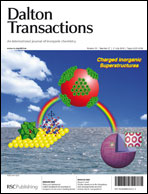Heterobimetallic Re![[double bond, length as m-dash]](https://www.rsc.org/images/entities/char_e001.gif) Pd complexes bridged by η1:η5-Ph2PC5H4 ligand. Synthesis, electronic and crystal structure of (CO)2(PR3)(η5-C5H4
Pd complexes bridged by η1:η5-Ph2PC5H4 ligand. Synthesis, electronic and crystal structure of (CO)2(PR3)(η5-C5H4![[upper bond 1 start]](https://www.rsc.org/images/entities/char_e010.gif) PPh2)Re–P
PPh2)Re–P![[upper bond 1 end]](https://www.rsc.org/images/entities/char_e011.gif) dCl2, R = Me and OMe†
dCl2, R = Me and OMe†
Abstract
The new ![[upper bond 1 start]](https://www.rsc.org/images/entities/char_e010.gif) PPh2)Re–
PPh2)Re–![[upper bond 1 end]](https://www.rsc.org/images/entities/char_e011.gif) dCl2
dCl2![[upper bond 1 start]](https://www.rsc.org/images/entities/char_e010.gif) PPh2)Re–
PPh2)Re–![[upper bond 1 end]](https://www.rsc.org/images/entities/char_e011.gif) dCl2
dCl2
![Graphical abstract: Heterobimetallic Re [[double bond, length as m-dash]] Pd complexes bridged by η1:η5-Ph2PC5H4 ligand. Synthesis, electronic and crystal structure of (CO)2(PR3)(η5-C5H4 [[upper bond 1 start]] PPh2)Re–P [[upper bond 1 end]] dCl2, R = Me and OMe](/en/Image/Get?imageInfo.ImageType=GA&imageInfo.ImageIdentifier.ManuscriptID=B927265H&imageInfo.ImageIdentifier.Year=2010)

 Please wait while we load your content...
Please wait while we load your content...
![[double bond, length as m-dash]](https://www.rsc.org/images/entities/h2_char_e001.gif) Pd complexes bridged by η1:η5-Ph2PC5H4 ligand. Synthesis, electronic and crystal structure of (CO)2(PR3)(η5-C5H4
Pd complexes bridged by η1:η5-Ph2PC5H4 ligand. Synthesis, electronic and crystal structure of (CO)2(PR3)(η5-C5H4![[upper bond 1 start]](https://www.rsc.org/images/entities/h2_char_e010.gif) PPh2)Re–
PPh2)Re–![[upper bond 1 end]](https://www.rsc.org/images/entities/h2_char_e011.gif) dCl2
dCl2